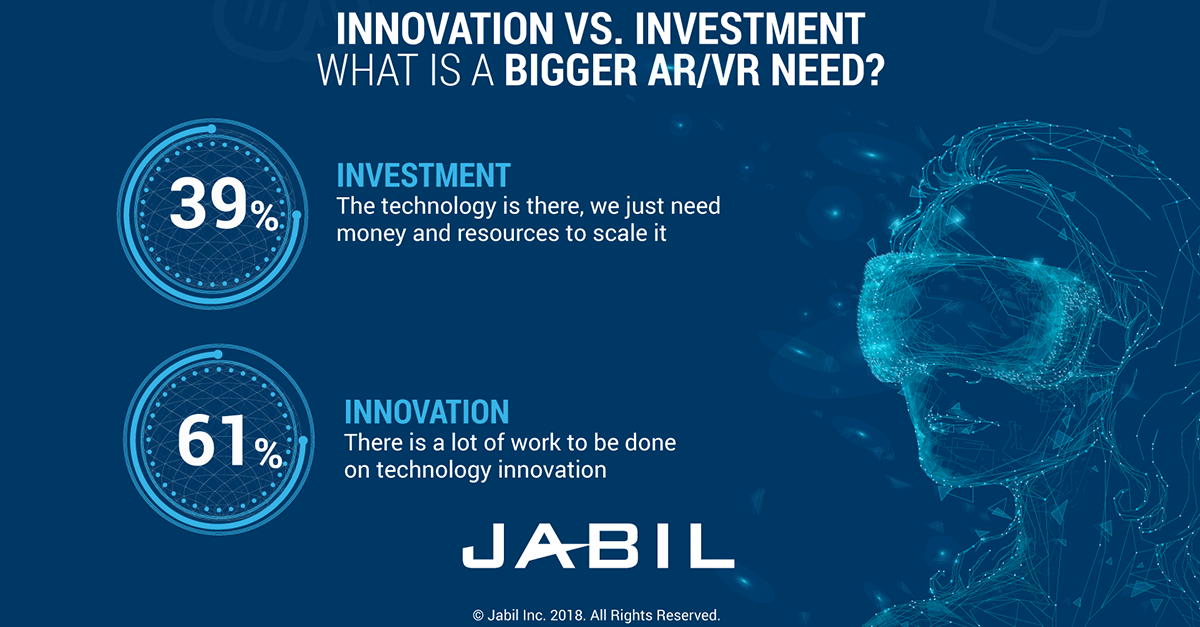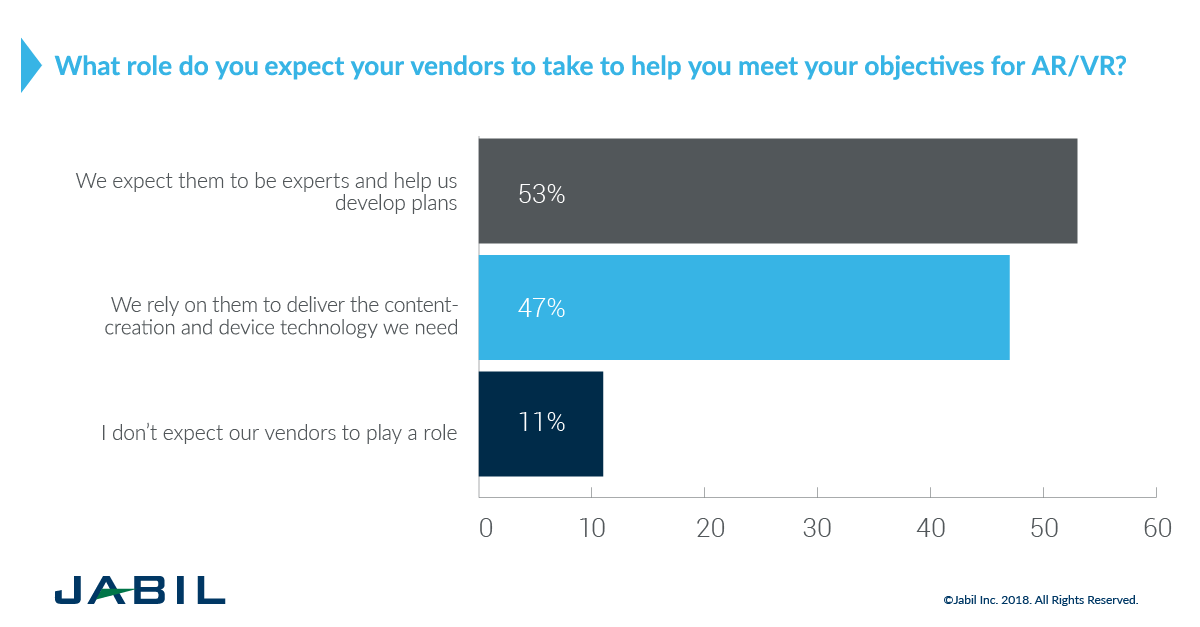Three Trends Supercharging Augmented Reality (AR) Technology

Augmented and virtual reality (AR/VR) are emerging technologies with tremendous market opportunity. But with VR and AR technology challenges and the absence of a "killer app," there is still a need for innovation and investment before AR/VR can go mainstream.
As companies navigate the choppy waters of AR/VR, they need to determine whether they should focus on innovation around underlying technology to soar ahead of the competition; or invest more money and resources to scale AR/VR. In Jabil's Augmented and Virtual Reality Trends Survey, 61 percent of business and technology stakeholders emphasized that there is still technology innovation work to be done.

Given the current state of VR and AR technology, this may be a good focal point. Today, we're in a state of compromise with augmented and virtual reality devices. None of the existing systems give users a complete, bondless and immersive experience.
"Today, we're in a state of compromise with augmented and virtual reality devices. None of the existing systems give users a complete, bondless and immersive experience.
In the race to create immersive, memorable customer experiences, companies must determine how AR/VR technologies play into this overarching goal. But perhaps it is most important to ask first: what are the technologies powering augmented reality?
Components Making Augmented Reality Possible
Augmented reality layers digital information and visuals onto the physical world through a device, thereby enhancing our existing reality. This allows the user to see and interact with actual or virtual objects in unconventional ways, often leaving the user's hands-free for other tasks. But creating these immersive experiences wouldn't be possible without four key components:
- Cameras: Over the last decade, cameras have become more integrated into our lives than ever before. Cameras are used in everything from gaming consoles to cars – and they're a key piece of augmented reality. When connected to a network, cameras yield real-time, actionable data that can power an immersive augmented reality experience.
- Sensors: Commonly used in today's connected devices, sensors enable our devices to be aware and interactive, giving them the ability to convert our environments into actionable data. Sensors are accessible, low-cost commodities thanks to interest in the Internet of Things (IoT). In augmented reality, sensors can support the camera's work with additional data on depth, location, sound, temperature, and other properties.
- Displays: Whether it's through a smartphone or a wearable headset, displays serve as the bridge between reality and digital content. The visuals or information is placed onto the real world through displays or projection systems, creating a seamless augmented reality experience.
- Communication and Processing Systems: Whatever the devices, these systems process and interpret every bit of data to create an accurate augmented reality experience. Devices must have enough processing power to support immersive, real-time AR. Since augmented reality is a high-volume experience, it needs the right match in power and memory.
Subscribe to the Jabil Blog
Sign up for weekly updates on the latest trends, research and insight in tech, IoT and the supply chain.
Technology Trends Will Supercharge Augmented Reality
While more AR technology innovation is needed, many of the trends we discuss and hear about daily will advance augmented reality to the next level.
- Artificial Intelligence: It seems that most industries are making significant investments in AI. With the success of voice assistants, the focus on AI is to enhance the technology to become smarter and more self-sufficient. According to Gartner, 40 percent of mobile interactions will be facilitated through smart agents on our devices over the next few years. Since AI is generated by the data provided, it offers a massive opportunity for those looking to leverage AR as their next venture. However, companies first need to have a defined vision – and the data to support that vision.
- Internet of Things: Current augmented reality technology relies only on the data one device captures. But as the much-anticipated power of IoT takes hold, things could change quickly. What if our AR technology could rely on more than one device? What if it could rely on hundreds? As sensors, cameras and interactivity become standard to every object imaginable, "smart" device communication can help us build a more immersive augmented reality experience.
- 5G Connectivity: We can discuss the potential convergence of AR, AI, and the IoT, but none of it will be possible without a reliable communication network. At our current 4G speeds, we are nowhere near the capacity to support an integrated ecosystem as the one described. While there are no worldwide standards, higher bandwidth and lower latency can be expected with 5G, providing users with seamless experiences. In the case of an AR device that collects data from numerous other IoT devices, 5G will enable this data exchange and connectivity at unprecedented speeds.
Augmented reality technology surely has a bright future across industries and daily use-cases. While we may discuss AR or VR in a singular fashion, we can't overlook the digital thread that connects these technologies with other emerging trends. Together, they will power our future.
Relying on Vendors to Meet Augmented Reality Plans
With all the change and technology advancement we're experiencing, it can be difficult to keep up. That is why companies are relying on their vendors and business partners to help meet their AR/VR objectives.

According to Jabil's Augmented and Virtual Reality Trends Survey, 89 percent of business and technology stakeholders expect support from their vendors, specifically in two areas:
- Developing Plans: Fifty-three percent of respondents say they expect their vendors to be AR/VR experts and help them develop plans accordingly. Therefore, it is important to emphasize once again – your vendors need to be experts in the thread that connects all emerging technologies, so they can make sound recommendations that will set your business up for success. Augmented reality is just one part of the puzzle.
- Deliver Content Creation and Device Technology: Most companies are experiencing challenges around content and technology, whether it's the high price of content creation or limitations around current consumer electronics. Consequently, 47 percent of stakeholders say they will rely on their vendors for content creation and device technologies.
Vendors can help companies navigate end-to-end product or content development, while allowing them to focus on their core strengths. With expectations that AR/VR will become mainstream over the next five years, the work you do today is critical for your company's future.
Augmented and Virtual Reality Trends Report
Insights from 201 managers and executives with responsibility for AR/VR decisions at companies that design, market and/or manufacture products.
